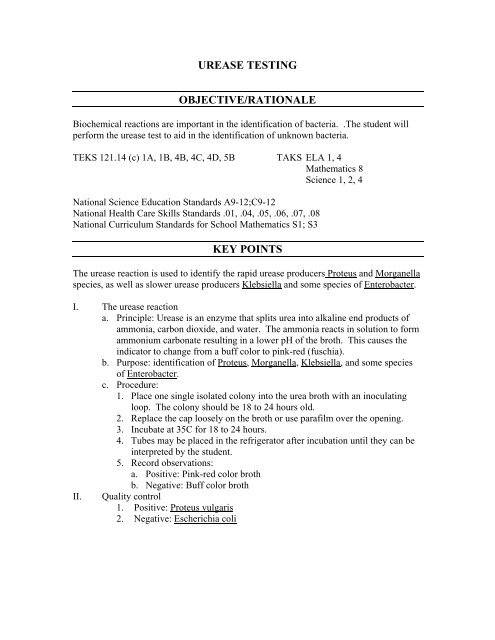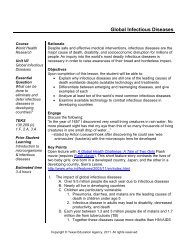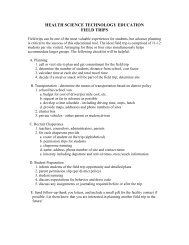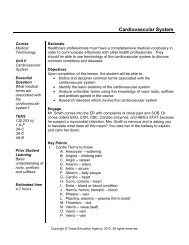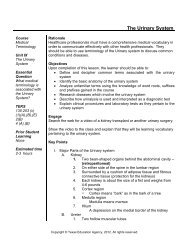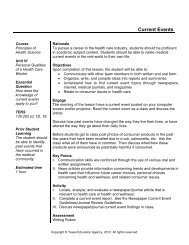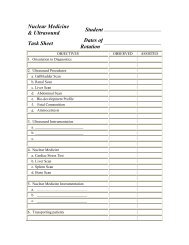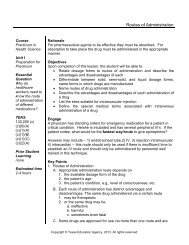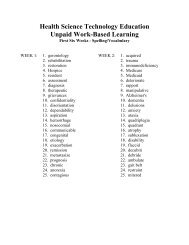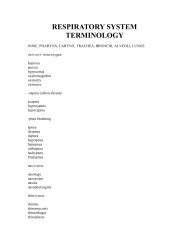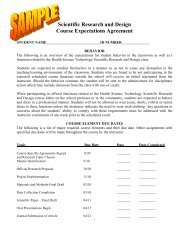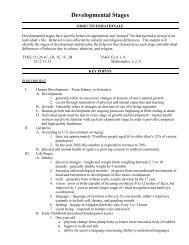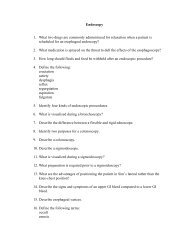Urease Testing - haspi
Urease Testing - haspi
Urease Testing - haspi
You also want an ePaper? Increase the reach of your titles
YUMPU automatically turns print PDFs into web optimized ePapers that Google loves.
UREASE TESTINGOBJECTIVE/RATIONALEBiochemical reactions are important in the identification of bacteria. .The student willperform the urease test to aid in the identification of unknown bacteria.TEKS 121.14 (c) 1A, 1B, 4B, 4C, 4D, 5B TAKS ELA 1, 4Mathematics 8Science 1, 2, 4National Science Education Standards A9-12;C9-12National Health Care Skills Standards .01, .04, .05, .06, .07, .08National Curriculum Standards for School Mathematics S1; S3KEY POINTSThe urease reaction is used to identify the rapid urease producers Proteus and Morganellaspecies, as well as slower urease producers Klebsiella and some species of Enterobacter.I. The urease reactiona. Principle: <strong>Urease</strong> is an enzyme that splits urea into alkaline end products ofammonia, carbon dioxide, and water. The ammonia reacts in solution to formammonium carbonate resulting in a lower pH of the broth. This causes theindicator to change from a buff color to pink-red (fuschia).b. Purpose: identification of Proteus, Morganella, Klebsiella, and some speciesof Enterobacter.c. Procedure:1. Place one single isolated colony into the urea broth with an inoculatingloop. The colony should be 18 to 24 hours old.2. Replace the cap loosely on the broth or use parafilm over the opening.3. Incubate at 35C for 18 to 24 hours.4. Tubes may be placed in the refrigerator after incubation until they can beinterpreted by the student.5. Record observations:a. Positive: Pink-red color brothb. Negative: Buff color brothII. Quality control1. Positive: Proteus vulgaris2. Negative: Escherichia coli
ACTIVITIESI. Complete the <strong>Urease</strong> Laboratory Investigation.MATERIALS/RESOURCESTSA plate with 18 – 24 hour cultures.Suggested bacteria:<strong>Urease</strong> positive: Nonpathogenic Proteus vulgaris<strong>Urease</strong> negative: Nonpathogenic Escherichia coliUrea broth tubesIncubatorInoculating loopsBunsen burnerGlovesLaboratory coat or apronBunsen burnerGogglesBiohazard containersSurface disinfectantPaper towelsLaboratory Investigation RubricASSESSMENTACCOMMODATIONSFor reinforcement, the student will review the steps in the urease procedure and repeatthe laboratory investigation.For enrichment, the student will research diseases caused by Proteus vulgaris.REFLECTIONS
UREASELABORATORY INVESTIGATIONNAME:DATE:PURPOSE:In this laboratory investigation, the student will learn the steps of urease testing.BACKGROUND INFORMATION:MATERIALS:TSA plate with 18 – 24 hour growth of the following bacteria:.Nonpathogenic Proteus vulgarisNonpathogenic Escherichia coliUrea broth tubesIncubatorInoculating loopsBunsen burnerGlovesLaboratory coat or apronBunsen burnerGogglesBiohazard containersSurface disinfectantPaper towelsPROCEDURE:1. Wash hands and put on gloves and goggles.2. Assemble equipment and materials.3. Prepare work area.4. Flame and cool the inoculating loop.5. Place one single isolated colony into the urea broth with an inoculatingloop. The colony should be 18 to 24 hours old.6. Flame and cool the inoculating loop.7. Replace the cap loosely on the broth or use parafilm over the opening.8. Incubate at 35C for 18 to 24 hours.9. Tubes may be placed in the refrigerator after incubation until thestudent can interpret them.10. Record observations:
c. Positive: Pink-red color brothd. Negative: Buff color broth11. Clean work area with surface disinfectant. Remove goggles and glovesand wash hands.DATA:Record the results of your testing by placing a X in the appropriate box.<strong>Urease</strong> ResultsBACTERIA POSITIVE NEGATIVEProteus vulgarisEscherichia coliCONCLUSION QUESTIONS:1. Morganella species infections are most often seen in what type of patients?2. Diagram the biochemical reaction of the urea test.3. How are urease positive organisms commonly transmitted? Identify signs andsymptoms of infection and the diseases they cause.4. Which Proteus species is most frequently isolated as a human pathogen?


